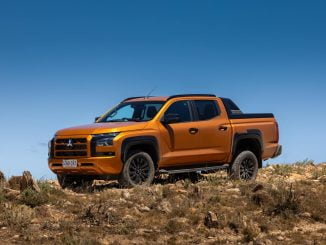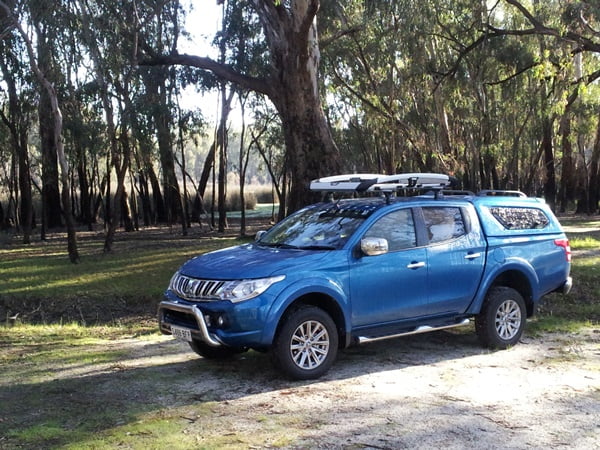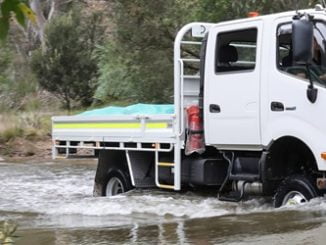
Fuso Canter – The heat is on in the 4×4 light-duty truck market and Fuso doesn’t intend to be left behind.
The Japanese brand has seen rivals Hino bring their 300 Series 4×4 to market in recent times (reviewed here), while Isuzu has just launched an updated version of the N-Series 4×4.
Who’s buying all these different trucks? Priority number one for the different manufacturers are operators like rural fire brigades and power companies for power line inspections etc.
Throw into the mix people who want to use a light-duty 4×4 as the platform for a go-anywhere campervan, as well as farmers and forestry service operators too.
There’s even some people who are choosing to upgrade to one of these vehicles out of large 4×4 SUVs and dual-cab utes.
So, there probably could be enough buyers in Australia for the different models, particularly as these really are quite adaptable vehicles and, while outwards appearances might suggest otherwise, they are all quite different.

I’ve driven all three now and can report they each have their own feel and personalities.
Most recently I got a drive in the Fuso Canter 4×4, steering a single-cab model across some pretty rough and tough countryside in Victoria.
I was also a passenger in the seven-seat crew-cab model.
Firstly, if you want an automatic transmission (or technically an Automated Manual Transmission – AMT) then you have only the one option – the Isuzu.
The Hino and Fuso are manual only at this stage.
All three are available in both single-cab and crew-cab, and all have low-range gearing.
So, what’s the Fuso like? Well, I have to say that it’s very impressive, and perhaps the most comfortable overall of the trio.
I thought the Canter rode along really nicely, even on corrugations and the steering is light, but quite direct.
The engine, a 3.0 litre turbo-diesel, gives you 147hp (from 2,840rpm) and 370Nm (from 1,350rpm).
True, the Fuso gives up an overall power and torque advantage to the competition, but on my test-drive it didn’t feel underdone and there was never the need to shift into low-range.
The comparable Isuzu 4×4 boasts 152hp (from 2,600rpm) and 419Nm (from 1,600) and the Hino gives 165hp (from 2,500rpm) and 464Nm (from 1,400rpm).
The test truck had two adults on-board and 900kg in the tray and I thought it accounted for it very well, the peak torque coming in at such a low engine speed perhaps being the secret.
 Some of the individual highlights of the Canter 4×4 include:
Some of the individual highlights of the Canter 4×4 include:
- Dashboard-mounted transmission selector (a more comfortable position than the Isuzu manual).
- The Fuso has the advantage of being able to access the engine from the cab by way of a traditional under seat hatch (this means you don’t have to tilt the cab to check the oil etc.), this is seen above.
- The tray height appeared to be lower than the competition, particularly the Hino. Officially, the rear frame height for the Fuso is 881mm, the Isuzu is 975mm and the Hino is 1,025mm.
- Select a single-cab Fuso Canter 4×4 and even with the factory tray your overall length is shorter than a Toyota LandCruiser 70 Series (unbelievable but true).
- Yes, you can get variants of both single-cab and crew-cab that can be driven on a car license.
- Standard kit in the Fuso includes dual airbags, sat-nav, Bluetooth, heated mirrors, and a reverse camera.
- Speaking of the mirrors, at first they seem a little small on the Canter, however they are convex mirrors and once used to them are actually quite effective.
- The driver gets a fold-down left armrest and suspension seat.
- Visibility from the driver’s seat in the Fuso product is very good.
- The gauges are clear and driver controls are generally well-placed and easy to use.
- There is excellent under-seat storage in the crew-cab model (seen below).
- The cab is acceptably quiet.
- Fuso’s offering comes with 30,000km service intervals (Isuzu = 20,000km and Hino = 20,000km)
 A couple of things that I noticed about the truck that you might want to consider, or that could be an issue for you:
A couple of things that I noticed about the truck that you might want to consider, or that could be an issue for you:
- I thought the grab handles were a touch small and only located on the one side of the door entry, this could make gaining access front and rear a bit difficult, especially if you aren’t overly flexible (the Hino probably leads in this regard, but it also appears to be a higher vehicle than the other two).
- There is no cruise control in the Fuso Canter 4×4 (Hino and Isuzu have it).
- Rear legroom in the crew-cab offering looks to be well short of the Hino, but around on-par with the Isuzu.
I look forward to spending an extended period of time in the Fuso Canter 4×4, especially on-highway/local roads to bring you a more detailed review of this vehicle.
Overall though I thought it was perhaps the most car-like of the Japanese 4×4 trio and one you’d be crazy not to check out.





